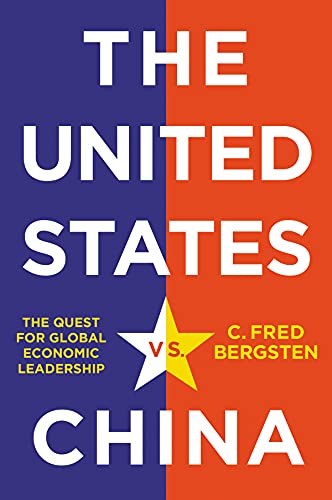
Review of The United States vs. China: The Quest for Global Economic Leadership by C. Fred Bergsten. Polity, 2022.
Within the next few decades, assuming their current charters are followed, the IMF and World Bank will be headquartered in China as the world’s largest economy. By this time, China, which has gotten “the best of both worlds from the present international order” by gaining “hugely from the order’s openness while cheating on the rules” may well have managed to rewrite those rules in its favor.
C. Fred Bergsten, founding director of the Peterson Institute of International Economics, seeks to “fill a critical gap in the other voluminous literature on the rise of China” by focusing on the contest for global economic leadership. Regrettably, the book breaks no new ground in its assertions that the United States must not abdicate global leadership, that it must get its domestic affairs in order, and that some compromise with China is inevitable.
The core of this work is a comprehensive examination of what it means to be the world’s dominant economic power. Somewhere in the relative balance of GDP and export volume, GDP per capita and the quantity of foreign reserves, national wealth and the stock of foreign investment, or perhaps just public perception, exists the threshold at which the mantle of global economic leadership can be claimed.
But if and when China eclipses the United States on most of these measures, that alone will not automatically confer it authority. Bergsten is right to question both China’s willingness and capacity to lead and to acknowledge the decisive role of middle powers in guiding the direction of the international system. Yet, for all Bergsten’s tables and charts of extrapolations, the most useful exhibit would have been historical. It is insufficiently appreciated that the foundation of the present system was made when the United States was not just the economic leader, but when it alone accounted for half of global production. China will never achieve this relative dominance.
A global vetocracy, akin to what Bergsten characterizes as a G0 scenario, seems likely. Any positive contributions to global governance will be offset by the steady erosion or irrelevance of prior arrangements. The two countries will likely be able to co-manage crises back to equilibrium even as the potential benefits of more substantive reform go unrealized. In this world, China and the United States are likely to engage in an assiduous competition for leverage, influence among middle powers, and brinkmanship. What Bergsten characterizes as American abdication of global leadership should be understood in this context. Much of the Trump administration’s egregiously disruptive behavior was actually intended to shore up the status quo, as evidenced by the largely marginal trade agreement with China. And if stepping back prompts allied middle powers to step up commensurate to their potential and self-interest while creating the political bandwidth for the United States to address its domestic challenges, so much the better.
Bergsten’s conception of economic leadership invests too little attention on the role of multinationals, the services trade, and the quality of domestic regulation. While Bergsten writes that “a vibrant private sector remains a cardinal element of US economic strength … a growing number of firms based in the United States now think and act like global rather than American entities.” Indeed, the United States must do more to minimize the potential for American corporations to be co-opted as agents of China’s influence. But that is a failure of its political system, not the corporations which excel at encoding liberal values throughout the markets in which they operate. Meanwhile, the potential of China’s private sector is being diminished by the CCP’s renewed assertion of control.
Similarly, to focus on the goods trade is to ignore that much of the highest value aspects of economic leadership occur in services. Here, the United States still exports nearly 4 times as much as China, as of 2018, a decline from nearly 10 times in 2000, according to UN Comtrade data. No less consequential is the intersection of America’s role as a major market, technological leader, and standard-setter. Boeing and the US Federal Aviation Administration’s fall from grace due to the 737-Max fiasco were arguably a far more consequential blow to American economic standing than any of the Trump-era obstructions at the World Trade Organization, but Bergsten mentions only the latter. And yet, China’s COMAC and Civil Aviation Authority remain as globally inconsequential as China’s companies and regulators in most other domains.
Two weeks on from the Russian invasion of Ukraine, it is too early to conclude what it portends for the global order. Has it awakened the West to the urgency of the authoritarian challenge that confronts them? Or will their unprecedented sanctions only accelerate technological and economic decoupling and the end of the dollar’s hegemony? Will China’s standing – and Xi’s rule – be weakened by its complicity or will it wrestle even greater influence from Russia over Central Asia as the price of its support and benefit from yet another impediment to America’s “pivot” to the Pacific?
What is not too early to conclude, however, is that to advocate for the “decoupling of the economic (and global commons) issues from more contentious security and values topics,” as Bergsten does, is folly. The strategic failure of the European Union has been to narrowly advance the former while the United States has privileged the latter. China’s leadership has long recognized that while political power grows out of the barrel of a gun, it is contingent upon the manufacturing, technology, and financing which produces it, and the ideology which directs its aim. The West can no longer afford to not take a similarly holistic understanding.